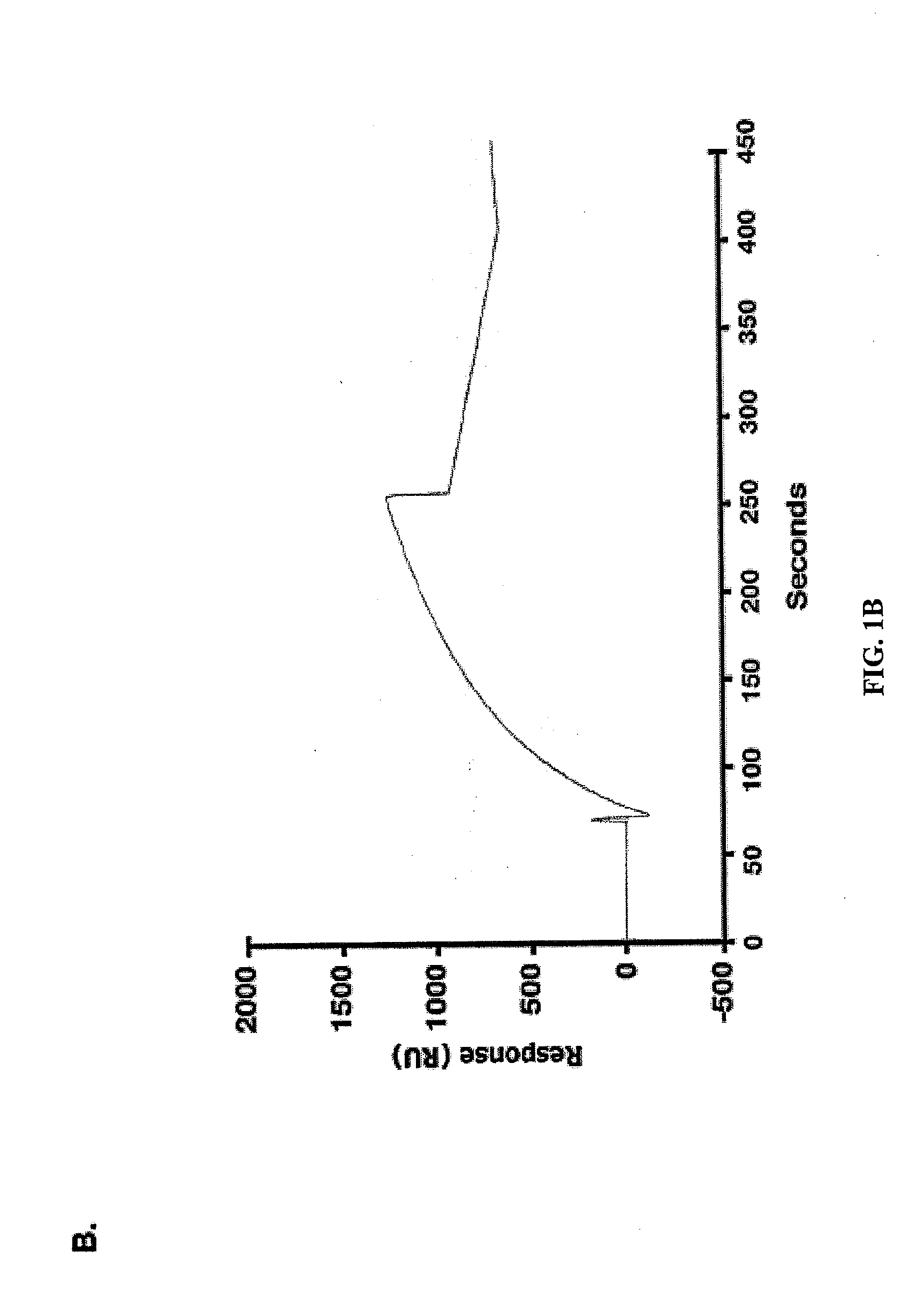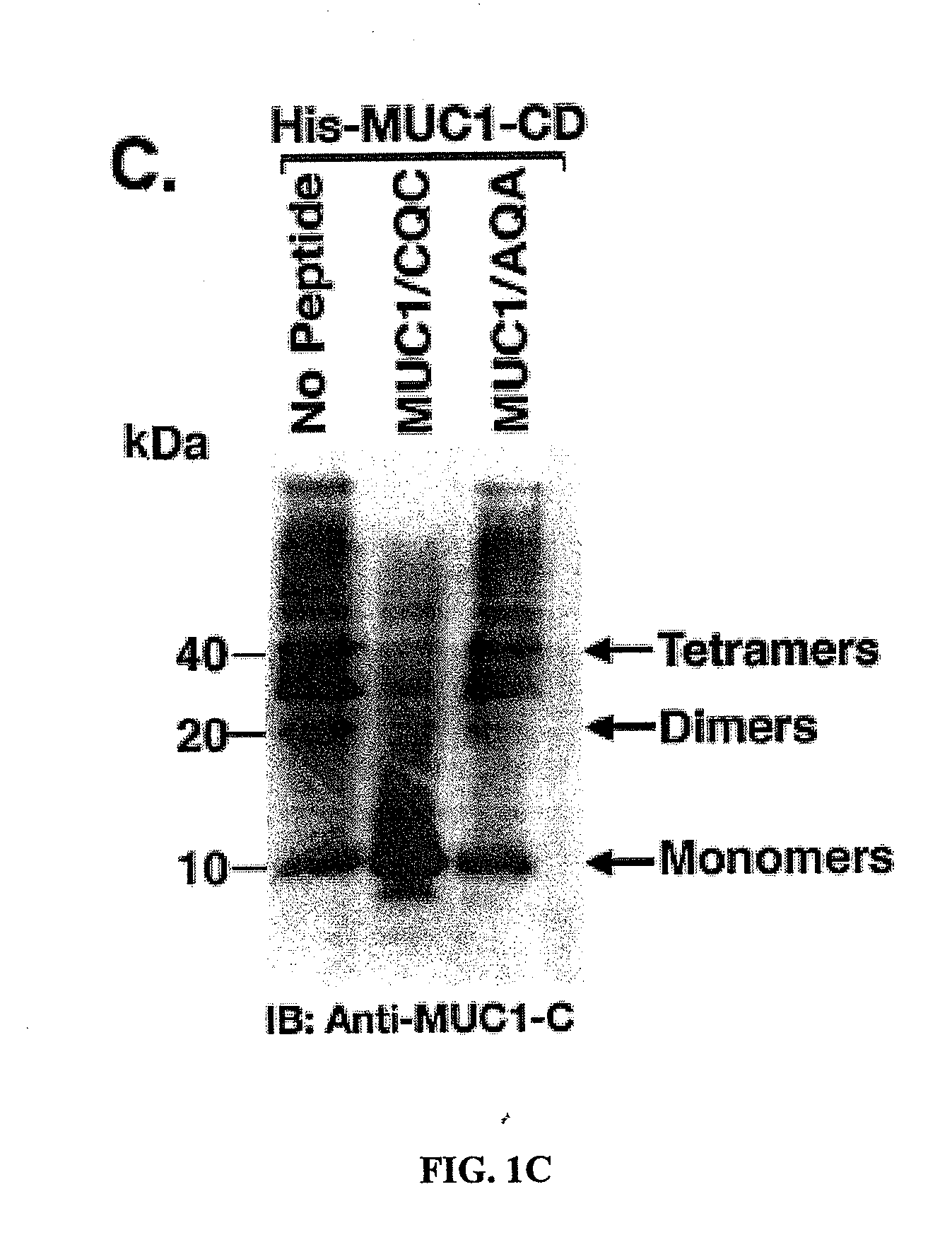Small molecule inhibitors of muc1 and methods of identifying the same
a small molecule and inhibitor technology, applied in the field of regulation of identification of inhibitors of muc1 inflammatory signaling, can solve problems such as reports of muc1 antagonists
- Summary
- Abstract
- Description
- Claims
- Application Information
AI Technical Summary
Benefits of technology
Problems solved by technology
Method used
Image
Examples
example 1
Materials and Methods
[0290]Cell Culture. Human breast cancer ZR-75-1, ZR-75-1 / vector, ZR-75-1 / MUC1siRNA (Ren et al., 2004) cell lines were grown in RPMI1640 medium supplemented with 10% heat-inactivated fetal bovine serum (HI-FBS), 100 U / ml penicillin, and 100 μg / ml streptomycin (Invitrogen) in a humidified incubator at 37° C. and 5% CO2. Human MCF-7 breast cancer cells and 293 cells were grown in Dulbecco's modified Eagle's medium with 10% HI-FBS, antibiotics and 2 mM L-glutamine. Human MCF-10A breast epithelial cells were grown in mammary epithelial cell growth medium (MEGM; Lonza). Cells were treated with the MUC1 / CQC or MUC1 / AQA peptides synthesized by the MIT Biopolymer Laboratory, Cambridge, Mass. Viability was determined by trypan blue exclusion.
[0291]Immunoprecipitation and Immunoblot Analysis. Whole cell and nuclear lysates were prepared as described (Leng et al., 2007). Soluble proteins were subjected to immunoprecipitation with anti-Flag (Sigma, St. Louis, Mo.). Immunopre...
example 2
Results
[0295]Effects of the MUC1 / CQC peptide on MUC1 oligomer formation. The MUC1 cytoplasmic domain (MUC1-CD) contains a CQC motif that is necessary for the formation of oligomers and nuclear localization (Leng et al., 2007). To determine whether a small molecule can be designed to block oligomerization, the inventors synthesized a peptide derived from the N-terminal region of MUC1-CD that contains the CQC motif (MUC1 / CQC peptide; FIG. 1A). A poly D-arginine transduction domain was included in the synthesis to facilitate entry of the peptide into cells (Fischer, 2007) (FIG. 1A). As a control, a similar peptide was synthesized in which the CQC motif was altered to AQA (MUC1 / AQA peptide; FIG. 1A). To assess binding of the peptides to MUC1-CD, the inventors immobilized His-tagged MUC1-CD to a BIAcore sensor chip. The MUC1 / CQC peptide bound to His-MUC1-CD with a dissociation constant (Kd) of 30 nM (FIG. 1B), which is similar to that obtained with MUC1-CD oligomers (Leng et al., 2007). ...
example 3
Discussion
[0316]MUC1 / CQC peptide blocks MUC1 oligomerization. Overexpression of MUC1 is sufficient for the induction of anchorage-independent growth and tumorigenicity (Li et al., 2003a; Huang et al., 2003; Huang et al., 2005). Notably, however, the MUC1 transforming function is abrogated by mutation of the CQC motif in the cytoplasmic domain to AQA (Leng et al., 2007). MUC1 forms oligomers and the CQC motif is necessary for this oligomerization (Leng et al., 2007). Moreover, oligomer formation is necessary for targeting of the MUC1-C subunit to the nucleus (Leng et al., 2007). Other functions of the MUC1-C subunit, such as activation of the Wnt / β-catenin and IKKβ→NF-κB pathways, are also dependent on the formation of MUC1-C oligomers (unpublished data). Based on these findings, the inventors reasoned that disruption of MUC1 oligomerization by a small molecule would have the potential to block the MUC1 transforming function. In that context, they synthesized a MUC1-derived peptide t...
PUM
| Property | Measurement | Unit |
|---|---|---|
| melting point | aaaaa | aaaaa |
| time | aaaaa | aaaaa |
| gel electrophoresis | aaaaa | aaaaa |
Abstract
Description
Claims
Application Information
 Login to View More
Login to View More - R&D
- Intellectual Property
- Life Sciences
- Materials
- Tech Scout
- Unparalleled Data Quality
- Higher Quality Content
- 60% Fewer Hallucinations
Browse by: Latest US Patents, China's latest patents, Technical Efficacy Thesaurus, Application Domain, Technology Topic, Popular Technical Reports.
© 2025 PatSnap. All rights reserved.Legal|Privacy policy|Modern Slavery Act Transparency Statement|Sitemap|About US| Contact US: help@patsnap.com



